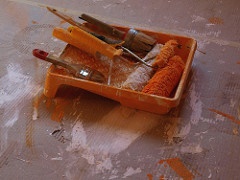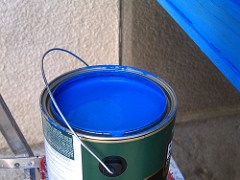You may view residential repair and painting favorably, but not the actual painting of drywall nearly as much. It starts out fun, but it rapidly falls into ordinary old grinding commercial labor, most notably when it comes to that second application.
After you have invested substantially in laying down that first layer, it is easy to declare it finished. Putting down the second layer seems an excessively labor intensive job for your design and worse, unnecessarily redundant business. You start to rationalize that this is an interior residential area, and actually how much wear and tear do they get?
Are there occasions when you can service the job well enough with a single application? What company offers a true one-coat, quality drywall paint? Is it worth the work, or the price?
 Bottom Line:
Bottom Line:One coat coverage is a business expression for a heavier, thicker acrylic-latex product, with up to 20% more paint solids, offering more body.
Ordinary commercial acrylic-latex can finish the area with one coat, but only under limited conditions.
Our view, we find it is always safest to put down two applications, despite a customer having these heavier options today.
One-coat paint for drywall has existed for years.
While a pound or two may not seem like much, it means everything where a quality coverage estimate is involved. That additional weight is one aspect that allows for a single-layer application.
You'll find the other aspect is product limitations. Reviews tell us the "One Coat Hide" guarantee policy does not efficiently service a job which offers white paint or to uncoated, porous, or repaired surfaces, a blanket restriction which encompasses a considerable amount of design territory.
Beyond these one-coat hues and back into the realm of ordinary acrylic-latex:
If you are driven not to address that loathed second turn, here are the instances where we estimate you might get by with that:
- When matching the existing shade, you find the area is still in good quality condition.
- Interior residential drywall, not exteriors.
- When used in conjunction with a pre-tinted primer.
- When painting ceilings.
- On quality trim, like crown molding, typically free from the risk of damage.
- On any residential business that matters less to you, like a seldom used basement bathroom or a guest bedroom.
 Why Painting Contractors Prefer Two Coats
Why Painting Contractors Prefer Two CoatsOnce you work to lay down your first layer and admire it, there is one problem: while at first look the color seems fine, the finished product in its truest sense is uneven and dull. Lit by your average room lighting, that shade is only reflecting about half of its potential brightness.
Professional painters utilize large, tripod-mounted illumination as they work. Light up your single-coated bedroom wall with these lights, and you will be surprised at the roller track marks and brush smears. Any wood filler or spackle will be apparent, showing through one coat.
The majority of the distress over laying down additional paint stems from reflecting on the work you put in initially preparing the area. The business of masking windows, performing repair, putting down drop cloths, removing light fixtures and outlet/switch plates, in addition to time acquiring the paint, tools, and other materials, is a lot of work. Often, this registers as part of the whole project estimate because the painter goes right from prepping to painting.
Consequently, with the business of prepping completed, that second round should take a significantly shorter time and less work to service than that first coat. All of that repair and difficult-to-apply masking tape remains in place.
You can ensure your work is easier by saving the roller and brush you utilized in the first coat, also saving time and clean up. Put the business end of the brush in a Zip-Loc bag and then in the freezer. Tightly wrap trays and the entire roller in a plastic garbage bag. Remove as much air as possible. This technique will maintain the brush or roller in a quality reusable state at least long enough for the first coat to dry.
Overall, well worth the price to phone a local professional painting contractor in Frisco, Tx and call for an estimate to accomplish the entire thing for you! Call Fantastic Finishes Paint Co. today and free yourself!
ABOUT FANTASTIC FINISHES PAINT CO.
Our contractors are fully bonded and insured with
the expertise to perform whatever task you may
require, efficiently and with customer satisfaction
as their first priority.
Contact us today for a free estimate! (972) 672-2512
Web Design, Hosting, and Online Marketing Provided By 2Surge Marketing